David Lynch’s as-yet-to-be-produced Ronnie Rocket: The Absurd Mystery of the Strange Forces of Existence has been covered many times before, usually couched under the question “will David Lynch ever make it?” It has also likely been covered at length in forums, but I have not consulted those sources. Of course, this is the screenplay he wrote immediately following Eraserhead. He has been quoted as stating that as the film sat so long without production—through Coppola’s interests before Elephant Man and the failed three-picture deal of the 90’s following Fire Walk with Me—the industrial setting would no longer communicate the same and that he felt the screenplay wasn’t where it needed to be. Given those notions, fans are left working through the two drafts of the screenplay that are available to them as well as connections to Twin Peaks: The Return, where it very well may have made its most striking visual, televised evolution. This article hopes to reach some of those aspects. Before starting, I would like to acknowledge a passage in David Hughes’s The Complete Lynch from 2001.
Today, Lynch admits that it has been ‘a long time’ since he last looked at Ronnie Rocket, and he feels that the moment to make it has truly passed. ‘If I had gotten the money to do it right when I wrote it, I think it would’ve been a different story. And now the script got out,’ he says, referring to the availability of several drafts on the Internet, ‘and that really hurts me.’ Not that people who have read the script would know what the film would be like, he says; after all, ‘the script is only a blueprint. But at the same time, I like to keep things private. Those kinds of things, for sure.‘[1]
This is followed by David Olson on the topic in his David Lynch: Beautiful Dark from 2008, where he explains:
But recently Jennifer Lynch told me, “The other day Dad looked at me with a gleam in his eye and said, ‘Jen, do you think this might be the time for Ronnie Rocket?,” so maybe the film isn’t dead and buried after all. Knowing Lynch’s passion for keeping the details of his work private until he feels it is ready to meet the public eye, I asked him if there was still a chance he would make Ronnie Rocket. His reply: ‘You probably shouldn’t write anything about it.’ But he did give me the okay to say a few things.”[2]
As a fan, myself, and hoping to be a responsible writer, I certainly acknowledge both points, published seven years apart, the latest ten years ago. The approach in this article, as I stated earlier, is that David Lynch’s Ronnie Rocket has found its way onto the screen in an unexpected way through Twin Peaks: The Return. Ronnie was to be a three-foot and a half tall character played by Michael J. Anderson, and I believe the unmade blueprint went through a similar evolution as Anderson’s The Arm experienced in The Return. Given these points and in hopes of honoring the screenplays as they exist in print, we’ll look at both drafts as space allows in this short format. Both drafts of the screenplay begin with a classic noir Detective talking to Ronald de Arte, who, without explanation, is in a mangled condition.
“There is no human form to him really except he does have arms and legs, but they’re under the sheets. The chest and head area are very strangely shaped, but there is a hole for a mouth and a nose. In the mouth there are teeth and a tongue which moves. There are two eyes above the nose hole. The eyes dart back and forth.”[3]
Given paper and pen, Ronald sets the Detective onto his adventure with scrawled symbols. I’m embedding both drafts’ versions below. In each draft there is included one symbol in the sketching that is a closed circle worth noting in the comparison.


In what I take as the second draft, the one which includes the subtitle The Absurd Mystery of the Strange Forces of Existence, Lynch has clearly decided to be more specific with his symbols, lending positive and negative aspects to them as if guiding us and the detective to note their meaning regarding electricity—positive and negative charges, protons and electrons. I am not an expert in the field, so bear with me. David Lynch is quoted as stating “I’ve been writing it for ten years, since I finished Eraserhead. It’s an absurd mystery of the strange forces of existence. It’s about electricity … about a three-foot tall guy with red hair and physical problems, and about 60-cycle alternating current electricity.”[4] In reading both drafts published online (I suspect another exists after ten years, as stated in the quote above), it seems to me that the key is his mentioning the 60-cycle alternating current. Much like David Foster Wallace’s Infinite Jest carries its narrative in fractals based on the Sierpinski gasket, it seems that Lynch’s Ronnie Rocket carries its narrative split, creating two worlds, parallel narratives, based on the 60-cycle alternating current. At this point, I’m going to borrow heavily from the experts.
In a flashlight the electric current always flows in the same direction. By an old convention dating back to Ben Franklin the flow is viewed as going from the positive (+) end of the battery, through the electrical load (e.g. lightbulb) whose resistance limits the intensity of the current, to the negative (–) end, closed by a return current inside the battery, which also generates the voltage by a chemical process. We call such a single-direction flow direct current or DC in short … The current flowing from outlets in the home is of a completely different kind. In the US it reverses direction 120 times each second, or 60 back-and-forth cycles each second (50 in Europe). That sort is known as alternating current or AC. It is not any harder for power stations to produce AC (indeed, it may be easier) and as will be explained, it is much more economical to send AC to greater distances than to send DC.[5]
Fascinating to note is that during the original airing of The Return, some fans began hinting at a notion that one could interpret Cooper’s journey in such a way—Agent Cooper = AC, while Double or Doppelganger Cooper = DC. The point is that as soon as the Detective in this screenplay leaves the hospital, he boards a train where he asks to go “deeper into the city,” a troubling notion to the conductor. From this moment, the Detective and Ronald’s journeys diverge. I suggest 60 cycles in one direction and 60 the other. Ronnie has to plug himself in every fifteen minutes. Perhaps, this plugs him back into the Detective’s narrative world in the same interval. According to Greg Olsen in his tome David Lynch: Beautiful Dark, “For Lynch, electricity is a powerful, invisible, mysterious force and its bifurcation into positive and negative polarities reinforces his tendency to perceive dualistic oppositions. Electrical circuits can be open or closed and in Ronnie Rocket Lynch applies this principle to energies of good and evil, the two polarities most fundamental to his narratives: Bad circuits must be broken for virtue to prevail.”[6] Now, a book would be required to explore each script scene-by-scene, so I will start by attempting a summation of the first screenplay then speaking to its significant revisions in the second. Further, we’ll explore specifically the narrative of the Detective, then that of Ronald’s, though they are interlaced in the screenplay as they would have appeared on screen.
One of the earliest Lynchian characteristics one could note prior to the divergence of the narratives, comes early in his descriptions of the city and their windows. “Only a few tiny yellow squares of light in the old buildings and factories. Everything is so dark. Very little life is noticed except the tiny dark yellow squares. There are no cars seen from this high angle looking down over the city … A closer look at some of the buildings reveals a thirties style architecture, although quite plain and very massive. Office buildings with heavy industrial factories.”[7] These tiny dark yellow squares could be envisioned as the tiny dark squares we see in the Fireman’s mansion in buildings throughout the “mauve zone” in The Return. Still, we have seen this imagery before, perhaps earliest at the home of Fred and Renee Madison in Lost Highway, not to mention on the architecture in various pieces of Lynch’s paintings. This has been more closely examined in Richard Martin’s The Architecture of David Lynch, where he notes in his introduction “The first building we met … was an unnerving distortion of domestic modernism, with a mottled facade broken only briefly by narrow glass slots and a larger window wrapping around one corner. It was instantly recognizable … as the setting of Lynch’s Lost Highway (1997), and it now contains the director’s editing suite and a screening room.” What this tells us is that Lynch carried his imagery from Ronnie Rocket and his paintings with him into his career. We may have even seen this shot in some aspect hovering over the New York skyline in The Return. The sense one gets is that he diffused this imagery throughout his filmography to fulfill his original vision which could never be made whole on the screen.

The Detective/Mr. Fry and Terry & Mr. Fry’s Brother
In the second draft of the screenplay, we have Ronald de Arte’s appearance established when “suddenly and mysteriously” the Detective is in the room, too. The Detective is already established as in the room in the first draft. As established the Detective takes a train toward the deep inner city, when two men board the train and look at him. When the Detective (this is his character, hence my capitalization) reaches the conductor’s end of the line, the Detective asks him about Mr. Fry. This is not in the second draft. We can also make our first insect notation as “Moths fly against the bulb … over and over again they hit at it, trying to get at the light. The Detective watches the moths.”[8] The Detective meets Terry, one of the men from the train. Their relationship is very different between the two drafts. In the first draft, Terry has a more clearly defined relationship with the second man on the train, Mr. Fry’s violent brother, Bill. Terry “… is an older man – rather mean looking and wears one pant leg rolled up exposing a gauze bandage. He carries a fly swatter with him and from time, swats his sore leg at the bandage.”[9] Terry isn’t impressed with the Detective’s inability to grasp his situation in Hank Bartell’s corrupted city, but he maintains hope as the Detective proves he can stand on one leg. In the first draft, a very familiar line of dialogue or verse occurs between “a hard low class girl and a smooth greasy tattooed man.” It will be completely omitted in the second draft.
GIRL
I got idea, man…you take me for a
walk (she moves closer to the guy)
under the sycamore trees (closer)
the dark trees that blow, baby. In
the dark trees I’ll see you and you’ll
see me…I’ll see you in the branches
that blow in the breeze…I’ll see you
under the trees.
GUY
I’ll twist your neck.
GIRL
NO, NO, NO, NO you won’t…I’ll
run away from you.
GUY
I’ll catch you…I’ll catch you
in the dark trees and kill you.
GIRL
NO, NO, NO[10]
In a scene also completely omitted from the second draft, the detective will pay for a night’s stay in the hotel he ducks into to avoid the violence between the man and woman. His room, 5B. Across the way, through his window, is a beautiful woman who looks up and smiles at him. She becomes a recurring symbol of good, and I suspect may have evolved into the character of Diana in the second draft. Downstairs, Bill and Terry come in and head upstairs for the Detective. It is noted that “Now in the hotel lobby is a man with a fairly large head piled high with wavy hair. He is in the shadows watching.” He has a terrible cough described as if he has tuberculosis. Bill and Terry leave with the Detective in tow. The tubercular cough worsens as they leave for the man now bowled over. When his coughing subsides and he looks up in the mirror, it’s the Detective. Terry and Bill end up with an empty shuck. In the second draft, Terry is much more an ally of the Detective’s though questioned all the time, and they have a new ally in Riley. I will leave you to read the rest of the scripts to finish the Detective’s journeys from one draft to the next. The vastly different endings will require a future article of examination.
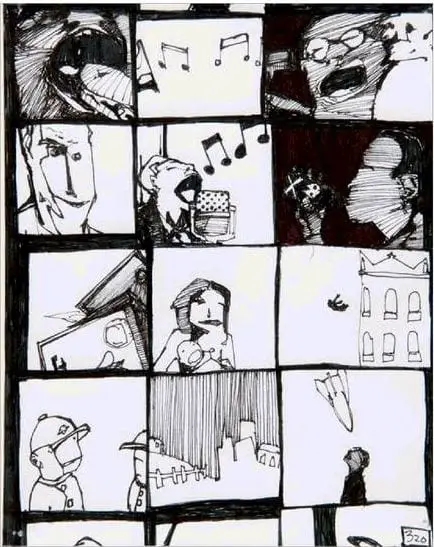
Ronnie Rocket, Dan Pink, Bob Platinum, & Deborah
Without context, in just reading the title Ronnie Rocket, one is reminded of Thomas Pynchon’s rocket imagery in Gravity’s Rainbow and its arched narrative with Tyrone Slothrop, perhaps even some of the black and white art of Zak Smith inspired by it. I’ve included some of that atmospheric imagery here simply due to my lack of offerings to illustrate the screenplay. Ronald’s narrative, though, could not be more different and can be summed up somewhat more simply than that of the Detective’s. Just understand that in each, it becomes clear that while their narratives have diverged, they must arch back toward each other to close the circuit. Ronald who will obviously come to be known as Ronnie Rocket is kidnapped from the hospital by rogue doctors (all of mad scientists), Dan Pink and Bob Platinum. These two are the coddled lovers of one Deborah. Their relationship includes slapstick violence amped way beyond the Three Stooges with malted milk breaks to bridge them. I attribute the malteds to Bob’s Big Boy scriptwriting sessions. In the Detective’s narrative, there are several instances of exposed breasts, which might be a way for Lynch to reflect the narratives from malteds to the mammary. (I’m just sending that out there as a possibility.) Still, constantly reading through these violent then subdued moments, one is reminded of Bugs Bunny’s held-to-hurl test tube concoction aimed at a pursuant scientist in Hot Cross Bunny, which turns out to be nothing more than a “chocolate malted.” We note the constant movement from innocence and treats to jarring adult discontent and violence. Dan Pink reminds one of The Return’s Special Agent Randall Headley with his dialogue.
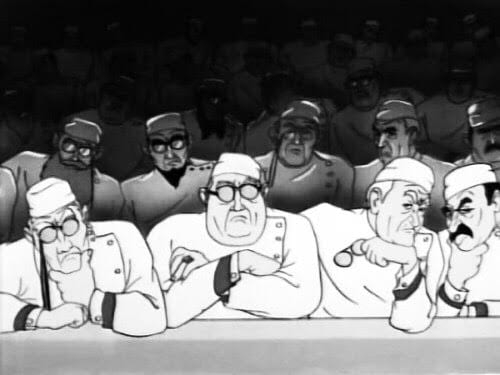
DAN
(panting)
No . . . I’m sorry, Bob. We’ll both
work on everything. That way it’ll
be perfect. You take an ear and
I’ll take an ear. We just have to
keep good measurements. . WE’VE
GOT TO KEEP GOOD MEASUREMENTS!!
(He buckles over and slams his
fist into his hand for emphasis)
Ronald de Arte is absolutely a stand-in for a mottled mound of clay, one that began as a sculpture-to-behold turned disaster, one that be must be reshaped, cherished, and never abandoned. Through the scientists’ artistic and Dr. Frankestein-esque efforts, Ronnie is brought to life with the rejuvenating attributes of electricity. He will have to learn to live in the world again, plugging himself into the sockets every 15 minutes. He will forever be a reaction to electricity. Dan, Bob, and Deborah enroll him in high school, determining his age to be sixteen. A high school bell ringing will send his skull back, mouth opened to the sky. He will repeat only the most child-like and pertinent words offered him in dialogue. But art made whole, he will be able to amplify beautiful music as a reaction. Still, so much of this forced action will eventually abuse the gift that he is. A perfect specimen, perhaps only to his creators, will be violently appropriated by money-hording gangsters. It will threaten his very existence. This occurs by the hands of Mr. Bucko, a violent and greedy rock band manager and his dangerous associate Mr. Green. As Ronnie Rocket is plugging himself in to recharge, members of a rock band are plugging in their equipment when they discover Ronnie’s unique abilities. Plugged-in and put on stage, Ronnie rocks violently and makes amazing reactionary sounds to the music but pays a heavy price every time; it’s an overload for him, one that Mr. Bucko couldn’t care less about. Mr. Pink and Platinum’s momentary greed in signing Ronnie to the band will be all of their un-doings.
Hank Bartells/Mr. Magic and the Donut Men
Based on the vast differences in drafts of these characters, it requires its own brief space. In the first draft, Hank Bartells has an alias, Mr. Magic. He is also none other than the “Donut Man.” He has corrupted the inner city with his bad electricity. He loses some of these names in the second draft, but it is the same character for our purposes. A particular characteristic from draft one struck me.
Hank does small dirty magic all the time as well as, his big magic. The small dirty magic for instance, may be making one of the bugs from outside slide into the center of the diner and catch on fire. This he’ll do in a minute, but right now he lights a cigarette by touching it on the table … Everyone turns to him and he points casually at the floor by the Detectives feet. In slides a bug under the door and bursts into flame in the center of the diner. He laughs a little and everyone laughs.[11]
This is where we can note the second insect in Ronnie Rocket. [To quickly note it, the third and final is an insect that crawls out of a person’s warts who has been poisoned by the electricity.] Hank’s small dirty magic reminds me of Red in The Return. His coin trick is a cheap one, but it screams of dark and menacing magic. Hank wreaks havoc upon the people of the inner city and particularly toward the Detective on his journey. His bad electricity confuses the brain, upsets the world, and ultimately kills its victims. His donut men precede him in their all-black suits, stabbing people with cattle prods. To untie their shoelaces is to break their closed circuits and defeat them. That leads us to a winding down point. Let’s look at bad electricity, some of its foils, and a bit more at Ronnie Rocket as expressed in The Return. The Circle Club and the two distinct endings of the screenplays will need to wait for their own future examinations as I stated earlier.
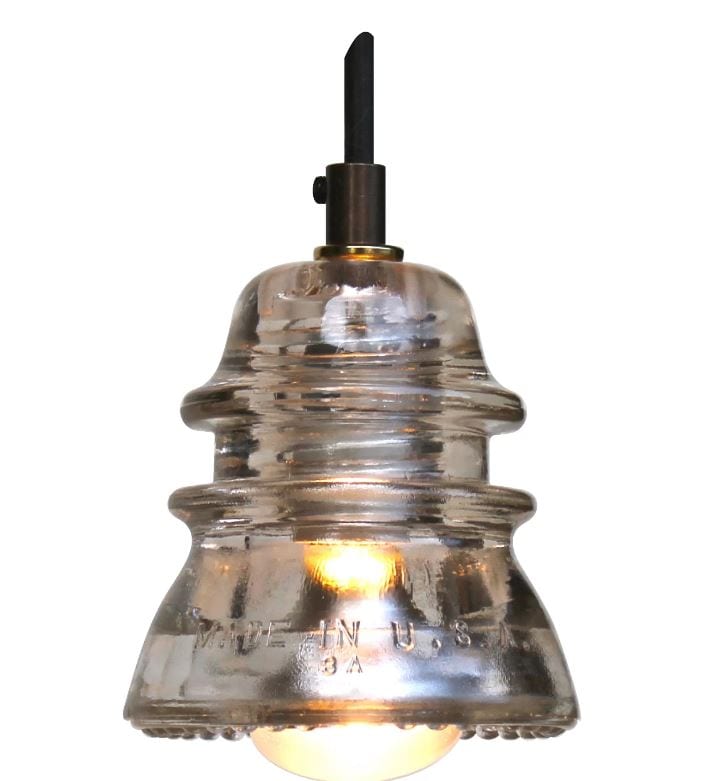
Bad Electricity, Insulators, & The Return
In the second draft of the screenplay, Terry and the Detective discover that pin collars and needles, the pain of them, can help them resist the debilitating and lethal “bad electricity” of the Donut Man (a.k.a. Hank Bartells). Greg Olson explains this well in the following quote.
Following his penchant for exploring the negative potential of something normally seen as positive … Lynch shows us the dark side of electrical power. …In Ronnie Rocket‘s city, the story’s villain spews out unseen waves of Bad Electricity that confuse people’s minds, gives them fits and skin diseases, makes them mutilate themselves, and saps their freedom of will. One of the pictures in which Lynch did get to explore his Bad Electricity concept was Twin Peaks: Fire Walk With Me, in which BOB’s dark impulses flow in telephone wires, hissing TV snow, and that iconic rotating ceiling fan.[12]
I believe we also see this expressed in The Return’s telephone lines leading to the Convenience Store as well as on Hawk’s living map in the black fire. What the new character of Riley in the second draft offers us is a black box, a distributor if your will. Did we see such a box in Argentina receiving DC’s phone messages? And that leads me to an image often called a bell or a tea pot in The Return. The human-sized, thimble-shaped bell that makes its appearance on the Mother’s box with Naido and Cooper, the Fireman’s mansion in Part 8, and with its steaming communicator in Phillip Jeffries has since its airing reminded me of some pieces my wife collects. I use them as ends for my meager Blu-ray collection. These are glass insulators used on telephone poles. It would make sense that the imagery of electrical insulators to protect against the bad electricity would work its way into the imagery of The Return. We could as easily call the space a “deep inner city” as Cooper is sent there from the box in New York with all of its electrical accoutrement to a space he must escape through a wall socket. Electricity will also force him to the surface of himself in Parts 15 and 16. Then, even at the mark for 430 in Part 18, we hear the definite electricity that Cooper is responding to. Let’s look at one last qualifying statement from Olson, which was published nine years before The Return.
Again typical for a Lynch work, a detective figure with a questing intelligence will strive to restore an illuminating order to a shadow zone of chaos. Like Lynch and many of his characters, Ronnie Rocket’s detective crosses barriers and boundaries to penetrate into realms of hidden knowledge, and he has to pay close attention to learn the new rules that help decipher the new places he’s exploring, and he receives guidance in his investigations.[13]
Between the two Coopers, there is a full 60-cycle alternating current, expressing a positive and negative charge. For them to come full circle, is to close the circuit, and for David Lynch, it is just possible that his renewed “pure love” of The Return is that he found a way to marry the two ideas forming a full circuited noir narrative where Cooper is whole and the bad electricity is held at bay by Carrie Page for the time being. But time is like a donut, and Lynch has told us may times “keep your eye on the donut;” it’s circular. So we end on F.B.I. Special Agent Albert Rosenfeld bewildered, calling his, Cole’s, and Preston’s renewed Blue Rose investigation exactly what it is: “The Absurd Mystery of the Strange Forces of Existence.”
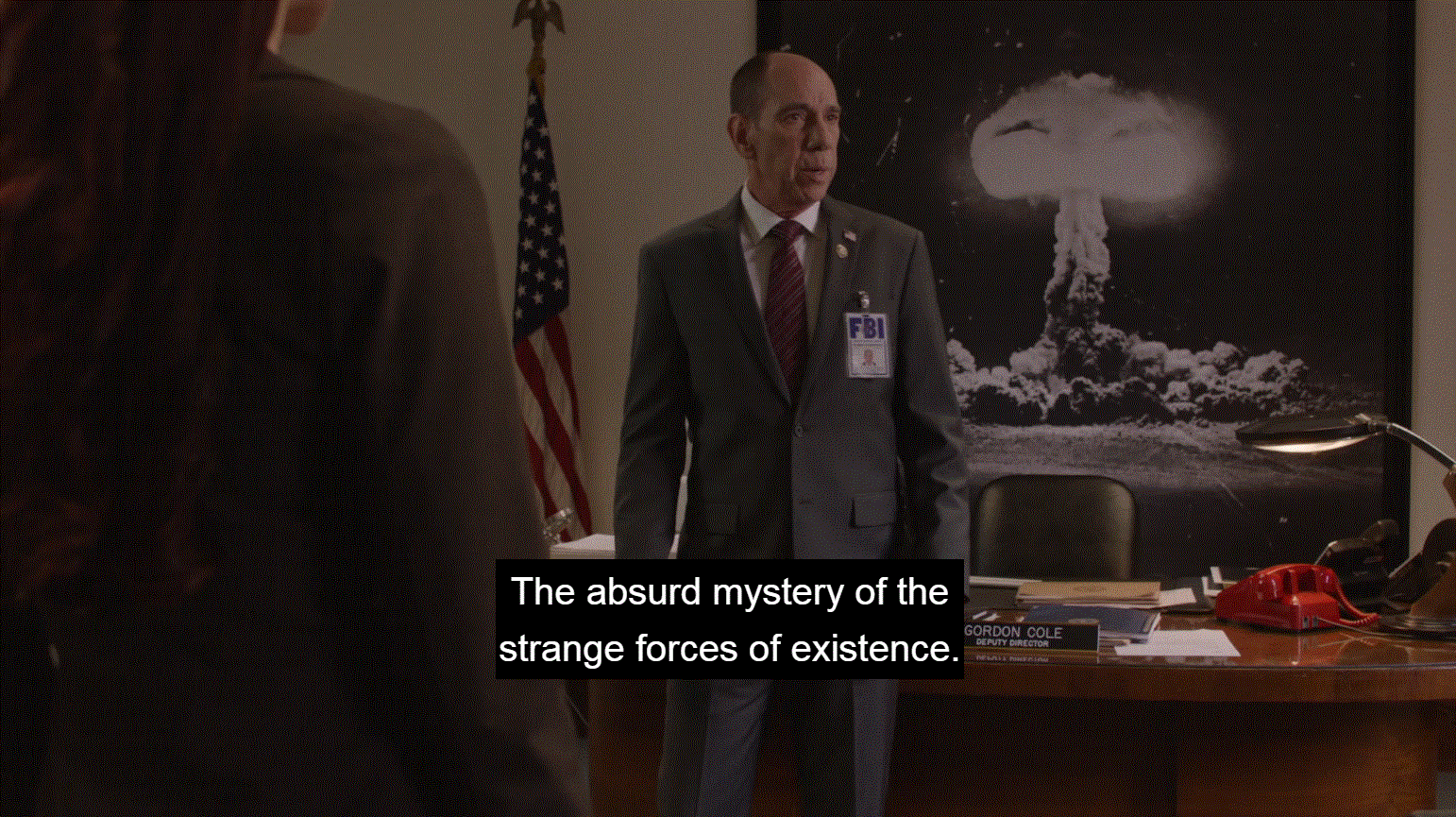
[1] Hughes, David. The Complete Lynch (London: Virgin, 2001), 249-250.
[2] Olson, Greg. David Lynch : Beautiful Dark. Filmmakers ; #126. (Lanham: Scarecrow Press, 2008), 144-145.
[3] Lynch, David. Ronnie Rocket: The Absurd Mystery of the Strange Forces of Existence, (Los Angeles: David Lynch, 1976), 1.
[4] Hartman, Mike. City of Absurdity.com: “About the Project.” Accessed April 1, 2018. http://www.thecityofabsurdity.com/ronnierocket.html
[5] NASA. “Alternating Current.” Accessed April 1, 2018. https://pwg.gsfc.nasa.gov/Electric/-E10-alternating.htm
[6] Olson, David Lynch: Beautiful Dark, p. 146.
[7] Lynch, David. Ronnie Rocket: [The Screenplay] ; [Draft 1] (Los Angeles: David Lynch, 1976), 1.
[8] Lynch, Ronnie Rocket: [The Screenplay] : [Draft 1], 5.
[9] Lynch, Ronnie Rocket: [The Screenplay] : [Draft 1], 11.
[10] Lynch, Ronnie Rocket: [The Screenplay] ; [Draft 1], 14.
[11] Lynch, Ronnie Rocket: [The Screenplay] ; [Draft 1], 60.
[12] Olson, David Lynch: Beautiful Dark, 145-146.
[13] Olson, David Lynch: Beautiful Dark, 146.

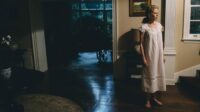

Fascinating stuff, what an incredible film this could have been.